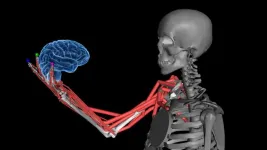(Press-News.org) A collaboration between scientists from St. Jude Children’s Research Hospital and Dana-Farber Cancer Institute uncovered four proteins that govern the identity of anaplastic large cell lymphoma (ALCL), an aggressive form of cancer. These proteins comprise a core regulatory circuit (CRC) that surprisingly incorporates a dysregulated signaling protein. Establishing the CRC for this lymphoma gives researchers insight into potential vulnerabilities that may be future therapeutic targets. The findings were published today in Cell Reports Medicine.
“Mutations in signaling pathways have long been known to drive oncogenic transformation and tumor progression,” said senior co-corresponding author Mark Zimmerman, PhD, currently of Foghorn Therapeutics, previously of Dana-Farber Cancer Institute and Boston Children’s Hospital. “Our new results show a mechanistic link in this aggressive T-cell lymphoma between aberrant signaling pathway activation and the dysregulated gene expression that is a hallmark of these tumor cells.”
ALCL patient tumors and models showed significant dysregulation of a protein called signal transducer and activator of transcription 3 (STAT3). STAT3 is a signaling protein that integrates information from other proteins, acting as a transcription factor (a protein involved in regulating the copying of genetic information from DNA into messenger RNA).
“We have found how dysregulation of the signaling protein STAT3 is central to enforcing ALCL cancer identity,” said co-corresponding author Brian J. Abraham, PhD, St. Jude Department of Computational Biology. “A healthy cell has a ‘Board of Directors’ made up of a few dominant regulators, and STAT3 gets ‘promoted’ from a division chief to a full board member with all the rights and powers that grants.”
Among the genes it controls, STAT3 increases expression of the protein MYC, which is well-known to be associated with cancers. Nearly every ALCL cell line tested showed either a mutation in STAT3 or in a protein that signals to STAT3, causing it always to be always “on” and directing gene expression, promoting perpetual cell growth through its targets.
The findings have implications for treatment because drugs that target the STAT family of proteins and other proteins that signal through STAT3 already exist.
Finding a core regulatory circuit for all ALCL subtypes
“Transcription factors and proteins that regulate the oncogenic gene expression programs are emerging as some of the most direct and effective targets for cancer therapy,” said first author Nicole Prutsch, PhD, Dana-Farber Cancer Institute and Boston Children’s Hospital. “STAT3 was already a recognized transcriptional activator in ALCL, but our research has identified a core transcriptional regulatory circuit hijacked by STAT3 to drive genes essential for ALCL cell growth.”
STAT3 hijacks three transcription factors that comprise the CRC: BATF3, IRF4 and IKZF1. All were expressed at high levels in ALCL cells, although they lacked any cancer-causing mutations. They were also identified as potential vulnerabilities in the DepMap Consortium gene knockout studies. When the scientists lowered the expression of any of these proteins, it significantly reduced cancer cell growth, demonstrating the centrality of the CRC.
“This is the first core regulatory circuit, to our knowledge, identified for ALCL,” Abraham said. Of the two major known molecular ALCL subtypes, anaplastic lymphoma kinase (ALK)-positive has an 80% survival rate, while ALK-negative has a 48% survival rate. Contrary to these differences, the researchers found both types relied on the same CRC.
“ALCL represents a diverse group of T-cell lymphomas with distinct clinical behaviors,” Prutsch said. “While ALK-positive cases respond well to ALK inhibitors, ALK-negative ALCL is highly aggressive and possesses limited targeted therapy options, highlighting the critical need for new treatment strategies.”
To understand the difference between the subtypes and find potential vulnerabilities, the researchers mapped special complexes of DNA and proteins called super-enhancers. These clusters of transcription-regulating elements are known to influence gene expression tightly. In cancers, super-enhancers can play a role in maintaining the cancer’s identity as a malignancy.
The scientists found that super-enhancers that differed among ALCLs converged to highlight the same CRC across ALCL tumors and models.
“The core regulatory circuit appears to be common across what have historically been treated as distinct diseases,” Abraham said. “Regardless of if an ALCL cell is ALK-positive or ALK-negative, it relies on the expression and the positive feedback provided by this circuit to stay ALCL.”
Potential vulnerabilities highlight treatment opportunities
Understanding the central role of the CRC in this cancer has implications for treatment. Drugs that target the STAT family of proteins and other proteins that signal through STAT3 already exist — but they have seen limited success, particularly in ALK-negative disease. Knowledge of the CRC and its interaction with STAT3 may allow for developing novel therapeutics and combination strategies.
“Our findings reveal a significant relationship between the core regulatory circuit members and STAT3,” Prutsch said, “This emphasizes the potential for therapies leveraging these connections and offers attractive options for developing new treatments in ALK-negative ALCL.”
The same methods used in the study may also provide a path to understanding and searching for vulnerabilities in other malignancies without a clear driver mutation.
“Our discovery indicates that exploiting the interconnectedness between signaling and transcriptional dependencies is a rational approach to developing new treatment strategies across a broad range of cancers,” Zimmerman said.
Authors and funding
The study’s other authors are Shuning He, Alla Berezovskaya, and Kimberly Stegmaier, Dana-Farber Cancer Institute and Boston Children’s Hospital; Neekesh Dharia, Genentech; Jamie Matthews, Lucy Hare, and Suzanne Turner, University of Cambridge, Addenbrooke’s Hospital; Lukas Kenner, Masaryk University; Olaf Merkel, Medical University of Vienna; and Adam Durbin, and Kelsey Maher, St. Jude.
The study was supported by grants from the National Institutes of Health (R35CA210064, R35CA210030 and K08CA245251), Lymphoma Research Foundation, Julia’s Legacy of Hope St. Baldrick’s Foundation Fellowship, National Institute for Cancer Research (Programme EXCELES, ID Project No. LX22NPO5102), European Union - Next Generation, Cancer Research UK Cambridge Centre (CTRQQR-2021\100012), Alex’s Lemonade Stand Foundation, Charles A. King Trust, Claudia Adams Barr Foundation and ALSAC, the fundraising and awareness organization of St. Jude.
St. Jude Children's Research Hospital
St. Jude Children's Research Hospital is leading the way the world understands, treats and cures childhood cancer, sickle cell disease, and other life-threatening disorders. It is the only National Cancer Institute-designated Comprehensive Cancer Center devoted solely to children. Treatments developed at St. Jude have helped push the overall childhood cancer survival rate from 20% to 80% since the hospital opened more than 60 years ago. St. Jude shares the breakthroughs it makes to help doctors and researchers at local hospitals and cancer centers around the world improve the quality of treatment and care for even more children. To learn more, visit stjude.org, read St. Jude Progress, a digital magazine, and follow St. Jude on social media at @stjuderesearch.
END
Scientists find core regulatory circuit controlling identity of aggressive leukemia
Scientists at St. Jude Children’s Research Hospital and Dana-Farber Cancer Institute found a small set of proteins that maintain anaplastic large cell lymphoma (ALCL) identity, representing potential vulnerabilities
2024-03-21
ELSE PRESS RELEASES FROM THIS DATE:
Organic fields increase pesticide use in nearby conventional fields, but reduce it in organic neighbors
2024-03-21
Expanding organic cropland can lead to increased pesticide use in surrounding conventional fields while reducing pesticide use on nearby organic fields, according to a study based in a leading U.S. crop-producing region. The findings provide insight into overlooked environmental impacts of organic agriculture and suggest that clustering organic fields could reduce pesticide use at the landscape scale. Organic agricultural practices are designed to have less negative local environmental impacts than other forms of intensive agriculture. However, the ...
Revealed: A gene underlying visual mating behaviors in Heliconius butterflies
2024-03-21
A particular gene plays a critical role in visual preference for mate choice between closely related Heliconius butterflies, according to a new study. The findings provide insight into how visually guided behaviors can be encoded within the genome. Many species use color and other visual cues to attract and recognize suitable mates. As such, visual preferences are important drivers of mate choice and sexual selection. However, while the genetics and evolution of the traits that serve as these cues – such as butterfly wing color – are ...
Novel approach yields better single-copy artificial human chromosomes
2024-03-21
Constructing human artificial chromosomes (HACs) in budding yeast overcomes the long-standing problem of uncontrolled multimerization – the rampant joining of similar molecules – and results in HACs that are large, stable, and structurally well-defined, researchers report. The findings may help advance chromosome engineering for precise genome editing in mammals and many other organisms. Artificial chromosomes can carry large numbers of engineered genes. Their use in bacteria and yeast as vehicles for writing and rewriting genomes has hinted at their potential to provide an alternative approach to editing genetic material in human cell lines. Although the first HACs were ...
A path forward from the “equity versus excellence” conflict that has impeded mathematics education in U.S.
2024-03-21
In a Policy Forum, Alan Schoenfeld and Phil Daro argue that the “equity versus excellence” controversy over how mathematics is taught has long disrupted education in the United States, particularly for underrepresented ethnic and socioeconomic groups. According to Schoenfeld and Daro, K-12 mathematics education in the U.S. is structured in ways that are problematic and do not reflect international trends. For more than 50 years, the typical yet rigid sequence of hierarchical mathematics courses – algebra 1 to geometry to algebra II to precalculus to calculus – has disenfranchised ...
How butterflies choose mates: gene controls preferences
2024-03-21
Tropical Heliconius butterflies are well known for the bright colour patterns on their wings. These striking colour patterns not only scare off predators – the butterflies are poisonous and are distasteful to birds – but are also important signals during mate selection. A team led by evolutionary biologist Richard Merrill from LMU Munich, in cooperation with researchers from the Universidad del Rosario in Bogotá (Colombia) and the Smithsonian Tropical Research Institute (Panama), has now exploited the diversity of warning patterns of various Heliconius species to investigate the genetic foundations of these preferences. ...
Mysterious exporter for brassinosteroid first identified
2024-03-21
When you are reading this article, there are multiple hormones working diligently inside your body to stabilize your health status. Same as human beings, it is impossible for plants to grow and reproduce without being regulated by phytohormones. One of the phytohormones is the Brassinosteroid (BR) hormones, also named as the sixth phytohormone.
According to a study published in Science on March 22, 2024, researchers led by Prof. SUN Linfeng from the Division of Life Sciences and Medicine of the University of Science and Technology ...
New reactor could save millions when making ingredients for plastics and rubber from natural gas
2024-03-21
Images
A new way to make an important ingredient for plastics, adhesives, carpet fibers, household cleaners and more from natural gas could reduce manufacturing costs in a post-petroleum economy by millions of dollars, thanks to a new chemical reactor designed by University of Michigan engineers.
The reactor creates propylene, a workhorse chemical that is also used to make a long list of industrial chemicals, including ingredients for nitrile rubber found in automotive hoses and seals as well as blue protective gloves. ...
How the brain senses body position and movement
2024-03-21
How does your brain know the position and movement of your different body parts? The sense is known as proprioception, and it is something like a “sixth sense”, allowing us to move freely without constantly watching our limbs.
Proprioception involves a complex network of sensors embedded in our muscles that relay information about limb position and movement back to our brain. However, little is known about how the brain puts together the different signals it receives from muscles.
A new study led by Alexander Mathis at EPFL now sheds light on the question by exploring how our brains create a cohesive sense of body position and movement. Published in Cell, ...
Species diversity promotes ecosystem stability
2024-03-21
Species diversity promotes ecosystem stability
Biodiversity loss may accelerate ecosystem destabilization
What maintains stability within an ecosystem and prevents a single best competitor from displacing other species from a community? Does ecosystem stability depend upon the presence of a wide variety of species, as early ecologists believed, or does diversity do the exact opposite, and lead to instability, as modern theory predicts?
Resolving a long-standing debate among ecologists
A new study from McGill University and ...
University of Calgary research finds a direct communication path between the lungs and the brain
2024-03-21
University of Calgary researchers have discovered the lungs communicate directly with the brain when there is an infection. Findings show the brain plays a critical role in triggering the symptoms of sickness, which may change the way we treat respiratory infections and chronic conditions.
“The lungs are using the same sensors and neurons in the pain pathway to let the brain know there’s an infection,” says Dr. Bryan Yipp, MD '05, MSc'05, clinician researcher at the Cumming School of Medicine and ...
LAST 30 PRESS RELEASES:
Making lighter work of calculating fluid and heat flow
Normalizing blood sugar can halve heart attack risk
Lowering blood sugar cuts heart attack risk in people with prediabetes
Study links genetic variants to risk of blinding eye disease in premature infants
Non-opioid ‘pain sponge’ therapy halts cartilage degeneration and relieves chronic pain
AI can pick up cultural values by mimicking how kids learn
China’s ecological redlines offer fast track to 30 x 30 global conservation goal
Invisible indoor threats: emerging household contaminants and their growing risks to human health
Adding antibody treatment to chemo boosts outcomes for children with rare cancer
Germline pathogenic variants among women without a history of breast cancer
Tanning beds triple melanoma risk, potentially causing broad DNA damage
Unique bond identified as key to viral infection speed
Indoor tanning makes youthful skin much older on a genetic level
Mouse model sheds new light on the causes and potential solutions to human GI problems linked to muscular dystrophy
The Journal of Nuclear Medicine ahead-of-print tip sheet: December 12, 2025
Smarter tools for peering into the microscopic world
Applications open for funding to conduct research in the Kinsey Institute archives
Global measure underestimates the severity of food insecurity
Child survivors of critical illness are missing out on timely follow up care
Risk-based vs annual breast cancer screening / the WISDOM randomized clinical trial
University of Toronto launches Electric Vehicle Innovation Ontario to accelerate advanced EV technologies and build Canada’s innovation advantage
Early relapse predicts poor outcomes in aggressive blood cancer
American College of Lifestyle Medicine applauds two CMS models aligned with lifestyle medicine practice and reimbursement
Clinical trial finds cannabis use not a barrier to quitting nicotine vaping
Supplemental nutrition assistance program policies and food insecurity
Switching immune cells to “night mode” could limit damage after a heart attack, study suggests
URI-based Global RIghts Project report spotlights continued troubling trends in worldwide inhumane treatment
Neutrophils are less aggressive at night, explaining why nighttime heart attacks cause less damage than daytime events
Menopausal hormone therapy may not pose breast cancer risk for women with BRCA mutations
Mobile health tool may improve quality of life for adolescent and young adult breast cancer survivors
[Press-News.org] Scientists find core regulatory circuit controlling identity of aggressive leukemiaScientists at St. Jude Children’s Research Hospital and Dana-Farber Cancer Institute found a small set of proteins that maintain anaplastic large cell lymphoma (ALCL) identity, representing potential vulnerabilities




